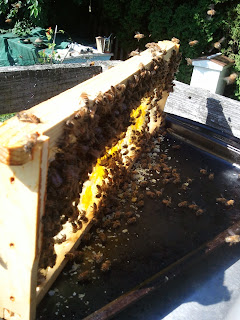I have been impatiently waiting to harvest honey. I have been uncertain how to go about it because I don't have an extractor. I used foundation, so cut comb or chunk honey are both out of the question as well. Three options were available to me. I could make, rent or borrow an extractor. I could do the crush and strain method or I could see what gravity could accomplish for extraction.
I don't know anyone who owns an extractor, so that option didn't work. I could rent an extractor from the RI Beekeepers Society, but I would have to join before I could rent, thereby doubling the cost. I could (and still might) make an extractor. I've seen a few plans and have some ideas of my own, but with all tinkering projects, time is a factor and I want honey now, damn it!
Crush and strain is exactly what it sounds like. You cut out all the comb, crush it in a pan or bowl and then put it all in a filtering bucket. It totally destroys all the hard work the bees have done making the comb, although the beekeeper (me) gets to keep the wax for other purposes. It seems a waste to go that route though.
Option three was the hands down winner... or so I thought. I figured that, although thick, you can still pour honey. The comb is angled down slightly to keep the thin nectar from spilling out. I figured it would be slow, but it should eventually drain, right? Well, no, not really. It may have worked better if I put it in the sun, but I didn't want the bees to rob the honey I had stolen from them. It was pretty warm in my house, though.
I grabbed a large bowl and mesh strainer for the cappings. I got a foil covered cookie sheet which fit the frame nicely. I grabbed my newly purchased uncapping knife and my scratching fork (which I didn't end up needing). I sliced the cappings off over the bowl. They came away from the rest of the comb nice and clean. Immediately, my kids wanted a taste of honey. A huge quantity of honey came away into the bowl, because the bees had drawn out the comb well past the stopping point. Apparently, the bees didn't read the same beekeeping books I read. I put the frame upside down for about half an hour.
Half an hour later, there was no real change. I thought, "Hmm. Maybe it would drain better with the frame on its side." Nope. After a while, I realized that the fruit flies would get the honey long before i did. I decided that I needed to do something. I couldn't very well leave an open dripping frame of honey somewhere, hoping that thieves with wings (or wingless with two legs) would steal it. Looking at the frame and my knife, I decided that the offset nature of the blade meant that I could successfully cut the comb off of the foundation, thereby leaving at least that intact for the bees next time.
I very carefully slid the knife into the comb down to the foundation. A slow sawing motion and a steady hand allowed me to keep from making any holes through to the other side. After straining through a mesh strainer, I poured the honey into a quart sized mason jar. I did the same to the other side. After the honey was extracted, I put the frame out for the bees to clean up. They seemed happy to oblige.
I collected a full quart plus an extra half pint mason jar from one medium frame. The honey was extremely light in color. It's even lighter than the bottle of clover honey in the cabinet. Based on the time this comb was filled and the directions the bees were flying and the things that were blooming, I would make a SWAG* that this honey is a mix of Northern Catalpa, white clover, and chicory with some various wildflower nectar thrown in for fun. Of course, without a centrifuge, a microscope and a library of pollen samples, I can't be sure.
Anyway, here are a few photos. I don't have any of the actual extraction because I really don't particularly like the idea of a glazed camera.
 |
| Bees on top of the top box as I remove the inner cover. |
 |
| A look down inside the hive at all that sweet honeycomb. |
 |
| One sting (on the face) seems like a fair price for this beautiful comb. |
 |
| Obviously, I left a lot of honey on this frame. I need an extractor. |
* SWAG - Acronym meaning Stupid Wild-Ass Guess
